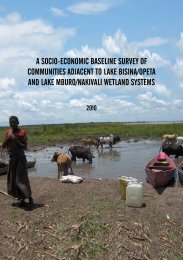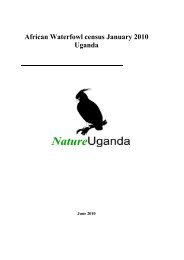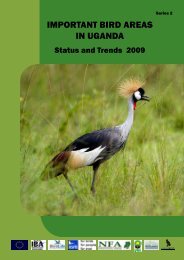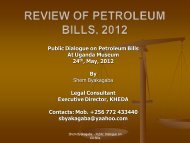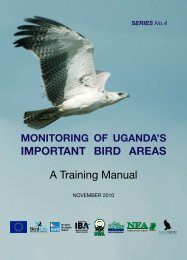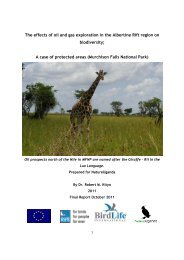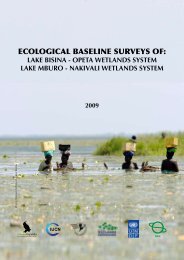the economic valuation of the proposed ... - Nature Uganda
the economic valuation of the proposed ... - Nature Uganda
the economic valuation of the proposed ... - Nature Uganda
You also want an ePaper? Increase the reach of your titles
YUMPU automatically turns print PDFs into web optimized ePapers that Google loves.
6.0. DISCUSSIONS AND CONCLUSION<br />
6.1. DISCUSSIONS<br />
The decision to degazette or not to degazette part <strong>of</strong><br />
Mabira CFR for sugar cane growing involves a range<br />
<strong>of</strong> considerations. The most important consideration is<br />
<strong>the</strong> comparative net returns to land from <strong>the</strong> different<br />
land uses, <strong>the</strong> o<strong>the</strong>rs being national policy, equity<br />
and environmental considerations and international<br />
obligations. The following section clearly demonstrates<br />
that whereas sugar cane growing is an important<br />
investment area for <strong>the</strong> economy, conservation <strong>of</strong><br />
Mabira Central Forest Reserve is an equally important<br />
land use option.<br />
• Why favour SCOUL only?<br />
A very disturbing question arising from a review <strong>of</strong> <strong>the</strong><br />
Mabira issue is why <strong>of</strong> all things <strong>the</strong> GoU feels SCOUL is <strong>the</strong><br />
producer best equipped to fill <strong>the</strong> production shortfall<br />
<strong>of</strong> 40,000 mt that currently exists when <strong>the</strong>re is ample<br />
evidence to show that despite being <strong>the</strong> oldest factory<br />
in <strong>the</strong> country and perhaps because <strong>of</strong> this, SCOUL is <strong>the</strong><br />
least efficient in terms <strong>of</strong> yield and conversion. It is true<br />
that SCOUL can point to some precedents in allocation<br />
<strong>of</strong> CFR land to agriculture, including sugarcane<br />
production. However, <strong>the</strong> argument is not sufficient to<br />
encourage <strong>the</strong> repeat <strong>of</strong> what obviously would appear<br />
to be a less than socially optimum decision.<br />
• Is sugarcane production superior?<br />
The first level <strong>of</strong> analysis is to ascertain whe<strong>the</strong>r it is<br />
better to convert 7,186 ha <strong>of</strong> Mabira CFR into sugarcane<br />
production instead <strong>of</strong> leaving it intact for conservation.<br />
The <strong>proposed</strong> land conversion to permanent agriculture<br />
would mean losing about US$ 35,236,471 <strong>of</strong> timber<br />
growing stock. It would also mean foregoing US$<br />
9,819,363 in form <strong>of</strong> annual benefits. Hence a total loss<br />
<strong>of</strong> about US$ 45,055 834 <strong>of</strong> conservation benefits would<br />
be incurred.<br />
On <strong>the</strong> o<strong>the</strong>r hand, converting a part <strong>of</strong> Mabira CFR<br />
for sugarcane production will require extensive land<br />
clearing which itself will be a significant cost to SCOUL.<br />
Secondly, benefit streams from sugarcane growing<br />
would start flowing about 18 to 24 months after land<br />
clearing (assuming planting is immediate). This time lag<br />
also represents opportunities foregone.<br />
Notwithstanding <strong>the</strong> foregoing, if <strong>the</strong> land clearing<br />
costs and those costs associated with <strong>the</strong> length <strong>of</strong> time<br />
it would take to harvest <strong>the</strong> first crop <strong>of</strong> sugarcane are<br />
set aside, it is possible to estimate <strong>the</strong> future net benefits<br />
realisable from sugarcane growing. In Chapter 3.0 <strong>of</strong> this<br />
report, it was reported that <strong>the</strong> average gross pr<strong>of</strong>it from<br />
sugarcane production by out-growers was US$ 490/<br />
ha. Therefore, <strong>the</strong> annual benefit stream <strong>of</strong> sugarcane<br />
growing would be US$ 3,593,000/year, over three times<br />
<strong>the</strong> estimated annual value from conservation. This<br />
probably is <strong>the</strong> justification by those who advocate<br />
for <strong>the</strong> conversion <strong>of</strong> forest land to agricultural use.<br />
However, this is a partial story, a ra<strong>the</strong>r narrow view<br />
<strong>of</strong> <strong>the</strong> benefits attributable to conservation.The net<br />
present value <strong>of</strong> <strong>the</strong> total benefits <strong>of</strong> conservation was<br />
estimated at US$ 45.1 million (standing timber stock plus<br />
present value <strong>of</strong> annual benefits). It is this value, ra<strong>the</strong>r<br />
than annual benefits alone which need to be compared<br />
with <strong>the</strong> alternative <strong>of</strong> agriculture. The net present value<br />
<strong>of</strong> <strong>the</strong> annual benefits from agriculture was estimated at<br />
US$ 29.9 million without making any deductions for <strong>the</strong><br />
initial costs associated with establishing <strong>the</strong> sugarcane<br />
plantation plus <strong>the</strong> time it would take for <strong>the</strong> first crop<br />
The Economic Valuation <strong>of</strong> <strong>the</strong> Proposed Degazettement <strong>of</strong> Mabira CFR | 2011 47



